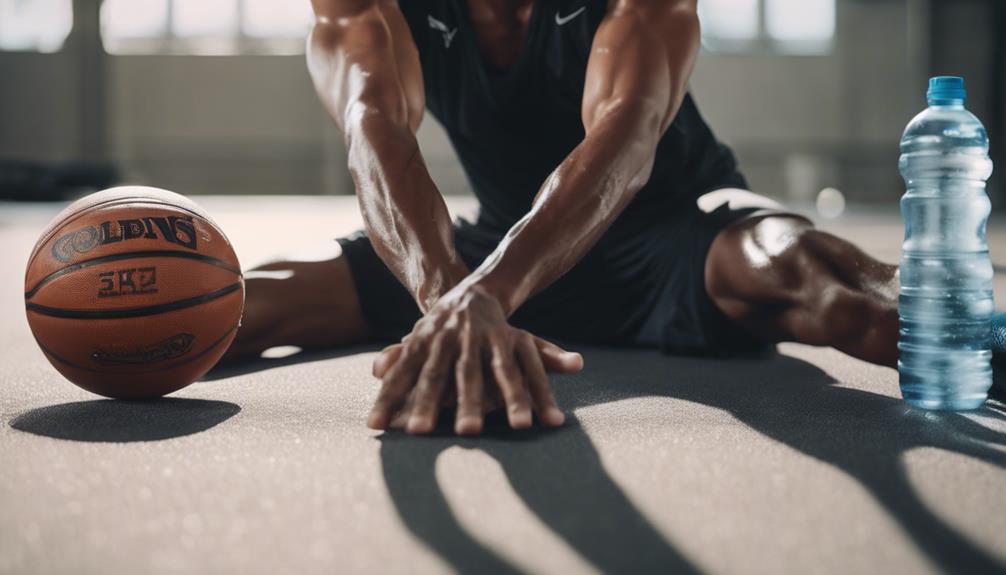Tips for Preventing Sports Injuries Before They Happen
Imagine your body as a finely tuned machine, capable of great feats when properly maintained. Now, picture the impact of a sports injury disrupting its function.
So, how can you ensure your body stays in top condition and injury-free during your physical activities? By incorporating a few simple practices into your routine, you can significantly reduce the risk of experiencing setbacks that could sideline you from your favorite sports.
Key Takeaways
- Engage in dynamic warm-ups, strength training, and flexibility exercises to prepare the body for sports activities.
- Select and maintain proper gear, stay hydrated, and replenish electrolytes for optimal performance and injury prevention.
- Focus on refining techniques, seek professional coaching, and follow injury prevention programs tailored to individual needs.
- Listen to your body, recognize early signs of strain, adjust training accordingly, and prioritize injury prevention and awareness.
Proper Warm-Up
To prevent sports injuries, it's crucial to ensure you engage in a proper warm-up routine before any physical activity. A key component of an effective warm-up is dynamic stretching. Dynamic stretching involves moving parts of your body and gradually increasing reach, speed, or both. This type of stretching helps improve blood flow to your muscles, increases your range of motion, and prepares your body for the demands of exercise.
Another important aspect of a proper warm-up is muscle activation. This involves performing exercises that specifically target the muscles you'll be using during your activity. Muscle activation helps prime your muscles for action, improving their responsiveness and reducing the risk of strains or tears during exercise.
Correct Gear Selection
Selecting the correct gear is essential for preventing sports injuries and optimizing your performance on the field or court. Ensuring that your sports equipment fits properly and is well-maintained can make a significant difference in your overall safety and comfort during physical activities. Here are some crucial points to consider:
- Proper Fit: Wearing gear that fits you correctly plays a vital role in injury prevention. Ill-fitting equipment can lead to discomfort, restricted movement, and increased risk of accidents. Make sure to adjust your gear according to your body size and type to maximize protection and performance.
- Equipment Maintenance: Regularly inspecting and maintaining your sports gear is key to its effectiveness and your safety. Check for any signs of wear and tear, such as fraying straps or cracked padding, and replace or repair them promptly. Properly maintained equipment can function as intended, reducing the chances of injury.
- Quality Over Quantity: Invest in high-quality gear that meets safety standards rather than opting for cheaper, subpar alternatives. Quality equipment is designed to provide optimal protection and durability, offering better support for your athletic endeavors.
Strength Training
When approaching strength training for sports injury prevention, prioritize exercises that target key muscle groups and improve overall stability and power. Muscle building is essential for injury prevention as it helps support your joints and protect against strains and sprains. Focus on compound movements like squats, deadlifts, and bench presses to engage multiple muscle groups simultaneously. Incorporating power training into your routine is also crucial for injury prevention. Power training involves explosive movements like plyometrics and kettlebell swings, which can enhance your ability to generate force quickly, reducing the risk of overuse injuries.
To prevent sports injuries effectively, ensure your strength training program includes exercises that address muscle imbalances and weaknesses. These imbalances can lead to poor biomechanics and increase the likelihood of injury. Additionally, incorporating functional movements that mimic sports-specific actions can help prepare your body for the demands of your chosen activity. Remember, consistency is key in strength training for injury prevention, so make sure to gradually increase the intensity and difficulty of your workouts over time. By focusing on muscle building and power training, you can proactively reduce the risk of sports-related injuries and enhance your performance on the field or court.
Flexibility Exercises
Prioritize incorporating dynamic stretching routines into your training regimen for enhanced flexibility and injury prevention. Dynamic stretching involves moving parts of your body and gradually increasing reach, speed, or both. This type of stretching is beneficial before workouts as it helps warm up muscles, increases blood flow, and boosts flexibility.
Here are three key points to consider when implementing flexibility exercises:
- Range of Motion: Dynamic stretching can improve your range of motion, allowing you to move more freely during sports activities and reducing the risk of muscle strains or joint injuries.
- Muscle Activation: These exercises activate different muscle groups, preparing them for the specific movements involved in your sport. This can lead to better performance and agility on the field.
- Injury Prevention: By regularly incorporating dynamic stretching into your routine, you can help prevent injuries caused by tight muscles, improve overall flexibility, and enhance your athletic performance.
Integrating these dynamic stretching routines into your workout plan can make a significant difference in your flexibility training and overall performance enhancement.
Hydration Importance
To optimize your athletic performance and prevent potential health risks, maintaining proper hydration levels is essential. Hydration plays a crucial role in your overall well-being and athletic abilities. When you exercise, especially in hot weather or for extended periods, your body loses water through sweat. It's vital to replenish this lost fluid to avoid dehydration, which can lead to fatigue, muscle cramps, and decreased performance.
In addition to water intake, maintaining electrolyte balance is also important. Electrolytes like sodium, potassium, and magnesium help regulate muscle function and nerve impulses. You can replenish electrolytes through sports drinks or foods like bananas and nuts. Be mindful of your hydration status throughout the day, not just during exercise. Thirst is a late indicator of dehydration, so aim to drink water regularly.
Remember that staying hydrated isn't only about drinking water during your workouts but also about maintaining a consistent level of hydration throughout the day. By paying attention to your water intake and electrolyte balance, you can support your body in performing at its best and reduce the risk of sports-related injuries.
Rest and Recovery
Optimizing rest and recovery after physical activity is crucial for enhancing your performance and reducing the risk of sports injuries. To ensure you're allowing your body to recuperate effectively, consider the following:
- Quality Sleep: Prioritize getting enough restful sleep each night to allow your body to repair and recharge for the next day's activities.
- Stress Management: Implement stress-reducing techniques such as mindfulness, deep breathing, or engaging in activities you enjoy to help your body recover from both physical and mental strain.
- Recovery Strategies: Incorporate active recovery techniques such as foam rolling, stretching, or gentle yoga to aid in muscle repair and reduce stiffness after intense workouts.
Balanced Nutrition
For optimal physical performance and injury prevention, maintaining a balanced nutrition plan is essential. Proper nutrient timing plays a significant role in supporting your body's needs during training and recovery.
When planning your meals, focus on incorporating a variety of nutrients to fuel your workouts and promote muscle repair. Carbohydrates are crucial for energy, so include whole grains, fruits, and vegetables in your diet. Proteins aid in muscle recovery and should be included in each meal. Lean proteins like chicken, fish, tofu, or beans are excellent choices. Healthy fats, such as avocados, nuts, and olive oil, help with joint health and overall well-being.
To optimize your performance, consider the timing of your meals and snacks. Fuel up with a balanced meal 2-3 hours before exercise and have a snack with carbohydrates and protein within 30 minutes after your workout. Stay hydrated throughout the day and listen to your body's hunger cues.
Technique Refinement
Improving your technique through focused refinement is key to enhancing your athletic performance and reducing the likelihood of sports injuries. Skill development plays a crucial role in injury prevention by ensuring that you execute movements correctly, reducing the strain on your body. When you refine your techniques, you not only improve your skills but also lower the risk of overuse injuries caused by incorrect movements.
Performance enhancement goes hand in hand with injury prevention. By refining your techniques, you can optimize your efficiency and power, leading to better performance outcomes while safeguarding yourself from potential injuries.
Key Points:
- Precision is Paramount: Pay attention to the finer details of your movements to prevent injuries and boost performance.
- Consistency is Key: Regularly refine your techniques to maintain optimal performance levels and reduce the risk of injuries.
- Seek Feedback: Engage with coaches or experts to gain valuable insights into improving your technique, promoting skill development, and preventing injuries.
Regular Check-Ups
Regular check-ups are crucial for monitoring your physical condition and detecting any potential issues early on to prevent sports injuries. By staying proactive with regular medical assessments, you can address any underlying problems before they escalate into serious injuries. Here is a table outlining the key reasons why regular check-ups are essential in injury prevention strategies:
| Benefits of Regular Check-Ups | Importance | Action |
|---|---|---|
| Early Detection of Risk Factors | Identifying potential injury triggers | Modify training routines accordingly |
| Monitoring Overall Health | Ensuring peak physical condition | Adjusting diet and exercise plans |
| Professional Guidance | Expert advice on injury prevention | Implementing targeted strength training |
| Injury Prevention Strategies | Tailored recommendations for your sport | Incorporating specific warm-up routines |
| Psychological Support | Mental health check-ups | Building resilience and focus |
Regular check-ups not only help in preventing injuries but also contribute to your overall well-being by providing personalized insights and guidance to keep you performing at your best.
Injury Prevention Programs
To enhance your athletic performance and minimize the risk of sports injuries, consider implementing structured Injury Prevention Programs tailored to your specific needs and physical demands. Injury prevention strategies are crucial in reducing the likelihood of getting injured during physical activity. These programs typically include a combination of strength training, flexibility exercises, and neuromuscular training to improve overall stability and reduce vulnerability to injuries.
Pre-game conditioning plays a significant role in preparing your body for the physical demands of sports activities, helping to prevent common injuries such as muscle strains or ligament sprains.
Key Points:
- Customized Programs: Tailored to your specific needs and physical demands.
- Comprehensive Approach: Including strength, flexibility, and neuromuscular training.
- Preventive Measures: Aimed at reducing vulnerabilities and enhancing overall stability for injury prevention.
Listen to Your Body
Listening to your body is essential in recognizing early signs of strain or overexertion during physical activity. Your body communicates with you through various signals, indicating when it needs rest or when you might be pushing it too hard. Pay attention to these warning signs to prevent potential sports injuries.
Rest signals can manifest as persistent fatigue, decreased performance, or lingering muscle soreness that doesn't improve with rest. When you notice these signs, it's crucial to listen and allow your body the time it needs to recover.
Ignoring these signals can lead to more serious issues like muscle strains, stress fractures, or overuse injuries. By tuning in to what your body is telling you, you can adjust your training intensity, duration, or technique to prevent harm.
Professional Coaching
When considering the importance of preventing sports injuries, seeking professional coaching can significantly enhance your athletic performance and reduce the risk of harm. Professional coaches offer valuable insights and guidance that can help you excel in your sport while minimizing the chances of getting injured.
- Coaching Techniques: Professional coaches are equipped with a wide range of coaching techniques that focus on proper form, technique, and injury prevention strategies. These techniques can help you perform at your best while reducing the risk of overuse injuries or accidents.
- Injury Management: Coaches are trained to recognize early signs of potential injuries and can provide guidance on how to manage them effectively. By addressing injuries promptly and following their advice, you can prevent minor issues from developing into more severe problems.
- Skill Development, Performance Enhancement: Professional coaching goes beyond just preventing injuries; it also focuses on skill development and performance enhancement. Coaches can help you fine-tune your abilities, optimize your training routines, and reach new levels of success in your sport.
Frequently Asked Questions
How Can Mental Preparation Help in Preventing Sports Injuries?
To prevent sports injuries, mental preparation is key. By utilizing visualization techniques and maintaining a positive mindset, you can enhance focus, confidence, and readiness, reducing the risk of injuries during physical activities.
Are There Any Specific Warm-Up Exercises That Can Target Injury-Prone Areas?
To target injury-prone areas, include hip mobility drills and core stability exercises in your warm-up routine. These help prepare your body for the demands of sports, reducing the risk of injuries and enhancing performance.
What Role Does Sleep Play in Preventing Sports Injuries?
Getting sufficient sleep is vital in preventing sports injuries. It impacts your body's recovery, performance, and overall well-being. Adequate rest is crucial for injury prevention as it allows for proper healing, muscle repair, and mental sharpness.
Can Cross-Training in Different Sports Help Reduce the Risk of Overuse Injuries?
Cross-training in different sports can help reduce overuse injuries by varying stress on specific muscle groups, improving overall fitness, and preventing burnout. Diversifying your activities enhances athletic performance and decreases injury risk.
How Can Proper Breathing Techniques During Exercise Help Prevent Injuries?
Focus on proper breathing techniques during exercise. Engage diaphragmatic breathing for optimal oxygen intake, enhancing performance and reducing injury risks. Cultivate mindfulness and relaxation through breath control. Prioritize technique to prevent injuries effectively.
Conclusion
In conclusion, by implementing these tips to prevent sports injuries, you can ensure that you stay healthy and perform at your best.
Imagine yourself on the field, feeling strong, agile, and confident in your abilities.
Take the necessary steps to protect yourself and enjoy the sports you love without the fear of getting hurt.
Remember, prevention is key in maintaining a long and successful athletic career. Stay safe and keep playing!













